The 2020 Mac Mini Unleashed: Putting Apple Silicon M1 To The Test
by Andrei Frumusanu on November 17, 2020 9:00 AM ESTBenchmarks: Whatever Is Available
As we’ve had very little time with the Mac mini, and the fact that this not only is a macOS system, but a new Arm64-based macOS system, our usual benchmark choices that we tend to use aren’t really available to us. We’ve made due with a assortment of available tests at the time of the launch to give us a rough idea of the performance:

One particular benchmark that sees the first light of day on macOS as well as Apple Silicon is Cinebench. In this first-time view of the popular Cinema4D based benchmark, we see the Apple M1 toe-to-toe with the best-performing x86 CPUs on the market, vastly outperforming past Apple iterations of Intel silicon. The M1 here loses out to Zen3 and Tiger Lake CPUs, which still seem to have an advantage, although we’re not sure of the microarchitectural characteristics of the new benchmark.
What’s notable is the performance of the Rosetta2 run of the benchmark when in x86 mode, which is not only able to keep up with past Mac iterations but still also beat them.
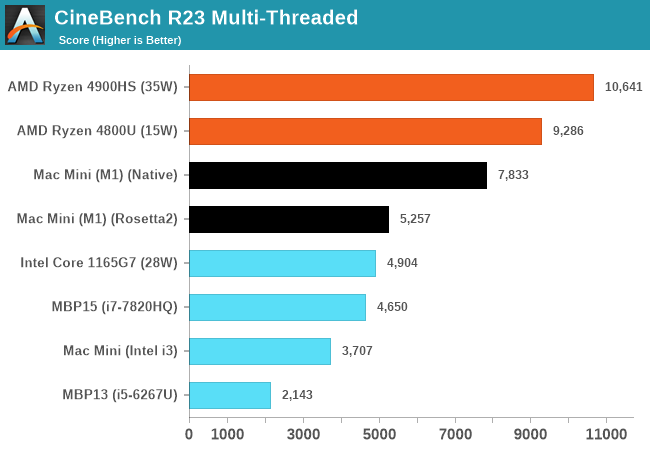
In the multi-threaded R23 runs, the M1 absolutely dominates past Macs with similar low-power CPUs. Just as of note, we’re trying to gather more data on other systems as we have access to them, and expand the graph in further updates of the article past publishing.
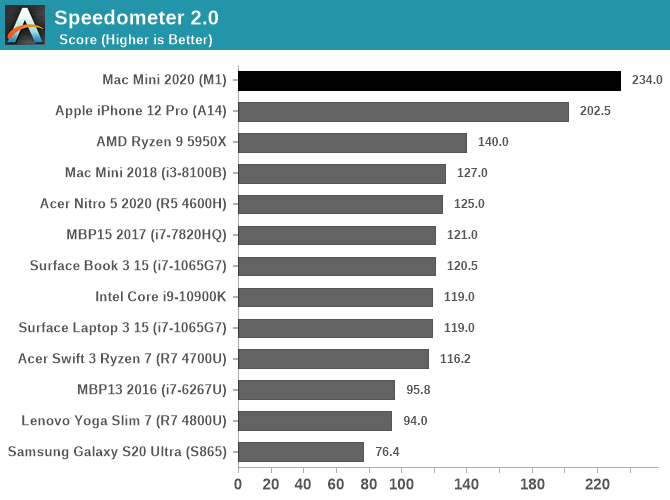
In browser-benchmarks we’ve known Apple’s CPUs to very much dominate across the landscape, but there were doubts as to whether this was due to the CPUs themselves in the iPhone or rather just the browsers and browser engines. Now running on macOS and desktop Safari, being able to compare data to other Intel Mac systems, we can come to the conclusion that the performance advantage is due to Apple’s CPU designs.
Web-browsing performance seems to be an extremely high priority for Apple’s CPU, and this makes sense as it’s the killer workload for mobile SoCs and the workload that one uses the most in everyday life.
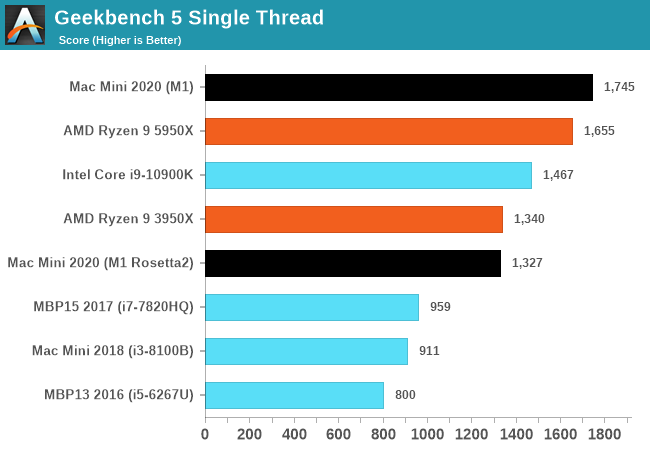
In Geekbench 5, the M1 does again extremely well as it actually takes the lead in our performance figures. Even when running in x86 compatibility mode, the M1 is able to match the top single-threaded performance of last generation’s high-end CPUs, and vastly exceed that of past iterations of the Mac mini and past Macbooks.
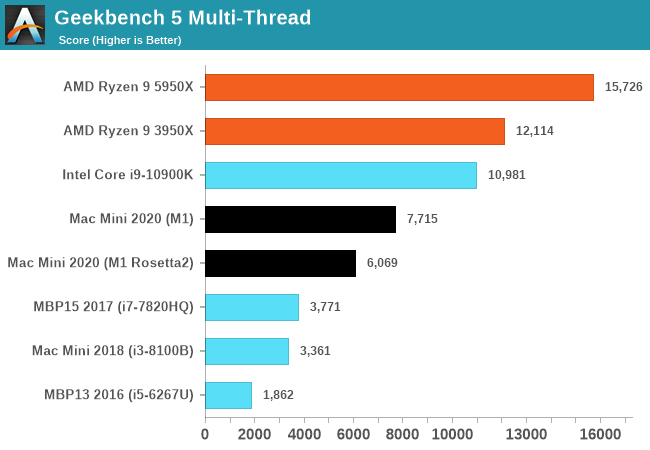
Multi-threaded performance is a matter of core-count and power efficiency of a design. The M1 here demolishes a 2017 15-inch Macbook Pro with an Intel i7-7820HQ with 4 cores and 8 threads, posting over double the score. We’ll be adding more data-points as we collect them.


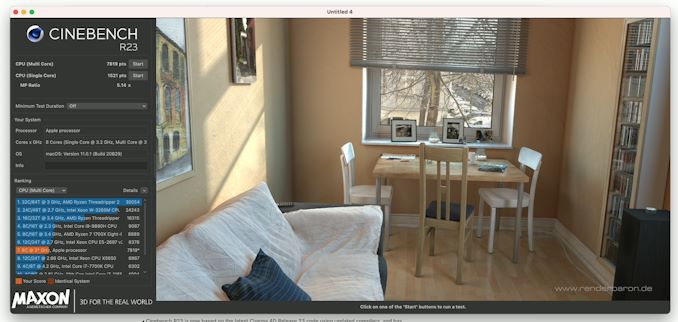








682 Comments
View All Comments
Spunjji - Tuesday, November 17, 2020 - link
Apples to Apples is comparing what's on offer to what's on offer. If AMD were on the verge of releasing Zen 4 I'd say hey, let's see what's in store, but you have to admit that right now Apple have leveraged 5nm to build a fundamentally solid design that has some significant competitive advantages.I suspect M1 will lose to AMD's offerings at the ~25W mark once Cezanne hits, which means good things for Zen 4 when it does indeed arrive, but this is a mighty good CPU as it stands at this time in 2020.
lilmoe - Tuesday, November 17, 2020 - link
Beating Intel doesn't say much. Intel is a well known issue in the tech industry. Apple isn't the only one complaining. Mobile Ryzen goes neck-to-neck with Intel desktop. This is well know fact. Apple doesn't have any breakthrough here; AMD did earlier this year. TSMC has great 7nm and a breakthrough 5nm process (Your move, Sammy).The M1 is Apple's A-Game in single thread. You won't see double digit improvements YoY.
Apples to apples (pro review):
- Consistent Charts.
- M1+Rosetta2 VS Zen2(4800U): THAT's what's available today.
- M1 Native vs Zen3 (Prediction/Analysis for Zen4): THAT is what M1/M2 Native will go up against.
- M1 Chrome/Javascript VS 4800U Chrome, NOT Safari+M1(Native) VS Chrome/Edge+4800U. That's a browser benchmark, not a CPU benchmark. Chrome all the way, then an educated prediction into how much Native would improve that.
- Actual popular games.
I'm dismissing this entire review. Any monkey can install and run a couple of benchmark apps.
andreltrn - Tuesday, November 17, 2020 - link
Why Chrome? What you people don't get is that people buying a Mac mini or a macbook air are buying a device. Like you would buy a refrigerator, a Nest thermostat. They will use what is the best for that DEVICE. They don't care about the processor. Even a processor (CPU) comparaison is bulls... when comparing the M1 with the AMD laptop offering. The M1 is a SOC with way more built-in functionality such as ML processor and accelerator and much more. A (intel or AMD) laptop CPU couldn't do what the M1 does in a properly coded app. EG. Final cut Pro or Logic or Safari for that mather. A device is the sum of it's parts. Not only a CPU specially in a laptop.vlad42 - Tuesday, November 17, 2020 - link
Why Chrome? Well because it is available for both operating systems. Of course another browser such as FireFox could also be used.We have seen time and time again that the web browser used can have an enormous impact on the results of browser based benchmarks. As you can see here in Anandtech's browser comparison on 9/10/2020, https://www.anandtech.com/show/16078/the-2020-brow... the Chromium version of Edge out performs FireFox in Speedometer 2.0 by roughly 35%! Since this article is not trying to compare the performance of different web browsers, the browser used should be kept the same.
In addition, since Speedometer 2.0 was made by Apple, it is highly likely that they likely put more weight on Safari updates improving the Speedometer score than, say, Google does with Chrome.
helpmeoutnow - Thursday, November 26, 2020 - link
@andreltrn lol keep it real. we are talking benchmarks. you can only compere software that runs on both systems.Spunjji - Tuesday, November 17, 2020 - link
Also, Zen 3 is in some of those comparisons... It wins as you'd expect, but dropping to 5nm wouldn't magically bring it to M1 power levels.vlad42 - Tuesday, November 17, 2020 - link
5nm would help by reducing the voltage, and thus power draw, for the chip. The bigger thing to remember is that there are no mobile versions of Zen 3 yet. Consider that the 5950X is only ~37% faster than the 4800U in single threaded Cinebench despite have a tdp 7 times higher. If the 5800U ends up having the same clocks as the 4800U, then the M1 would roughly have a 7% perf/W advantage. Granted, this assumes the 5800U’s score would be 19% faster than the 4800U's 1199.So, given the expected benefits that TSMC, Samsung, etc. have touted about 5nm, a die shrink from 7nm to 5nm would easily make up for this difference in power efficiency.
R3lay - Wednesday, November 18, 2020 - link
You can't compare single core performance and then compare then to the TDP. At single core the 5950X doesn't use 7x more power.Kangal - Saturday, November 21, 2020 - link
To be honest, a lot of comparisons of the Apple Silicon M1 are vague, misrepresentative or blatantly off. The best representative benchmarks I've seen are:Single Core, Geekbench v5, 5min run, Rosetta2
2020 Macbook Air (10W M1): ~1300 score
2019 MacBook Pro 16in (35W i9-9880H): ~1100 points
AMD Zen2+ Laptop (35W r9-4900HS): ~920 points
2019 Macbook Pro 13in (15W i5-8257U): ~900 points
AMD Zen2+ Laptop (20W r7-4800U): ~750 points
Multi-Thread, CineBench r23, 10min run, Rosetta2
AMD Zen2+ Laptop (35W r9-4900HS): ~11,000 score
AMD Zen2+ Laptop (20W r7-4800U): ~9,200 score
2019 MacBook Pro 16in (35W i9-9880H): ~9,100 score
2020 Macbook Air (10W M1): ~7,100 score
2019 Macbook Pro 13in (15W i5-8257U): ~5,100 score
Rendering Performance, Final Cut ProX, 10min clip
AMD Zen2+ Laptop (35W r9-4900HS): error on ryzentosh
AMD Zen2+ Laptop (20W r7-4800U): error on ryzentosh
2019 MacBook Pro 16in (35W i9-9880H): ~360 seconds
2020 Macbook Air (10W M1): ~410 seconds
2019 Macbook Pro 13in (15W i5-8257U): ~1100 seconds
GPU Performance, GFXBench v5 Aztec Ruins High, Rosetta2
2019 MacBook Pro 16in (i9 5600M): ~79 fps
2020 Macbook Air (M1 8CU): ~76 fps
AMD Zen2+ Laptop (r9 Vega-8): ~39 fps
AMD Zen2+ Laptop (r7 Vega-7): ~36 fps
2019 Macbook Pro 13in (i5 Iris Pro): ~20 fps
Gaming Perfomance, Rise of the Tomb Raider, 1080p High
2019 MacBook Pro 16in (i9 5600M): ~70 fps
2020 Macbook Air (M1 8CU): ~40 fps
AMD Zen2+ Laptop (r9 Vega-8): ~23 fps
AMD Zen2+ Laptop (r7 Vega-7): ~21 fps
2019 Macbook Pro 13in (i5 Iris Pro): ~12 fps
....so I share the well-grounded outlook that Dave Lee (D2D) has on the matter, where Linus (LTT) was more pessimistic than Dave but I think his opinions are pretty neutral overall. I simply out-right reject the unprofessional and unrealistic look that Andrei (Anandtech) has displayed in the previous article. Nor am I fully on-board with the overly-optimistic perspective that Jonathan Morrison demonstrated.
Kangal - Saturday, November 21, 2020 - link
More thoughts on the matter...I get there's the argument to be made that: new modern and more efficient apps are coming natively, that single-core is most important, low TDP is very important, and race to idle (or at least race to small cores) is important. From that perspective, the M1 in the Macbook Air is the best by a HUGE margin. We're talking a x3 better overall experience than the best x86 devices in such comparisons.
Then there's the alternate debate. That what you get is, what you get. So that legacy program performance is most important, single-core is no longer be-all-end-all, multi-thread being relevant for actual "Pro" users, and just as important as TDP is the Sustained Performance. When looking from that perspective, the Apple M1 in a MacBook Pro 16/13 is only equivalent to the very best x86 device performances. So basically a meh situation, not a paradigm shift.
So what can we realistically postulate from this, and expect from Apple and the industry?
Firstly, Apple disappointed us with the M1. In short, Apple played it safe and didn't really do their best. That means they purposely left performance on the table, it was artificial and it was deliberate. The why is simple, just so that they can incrementally introduce these increases, that way they can incentivise customers. In long, what they have now, the 4/8 setup is somewhat reminiscent to the current high-end phablets, or the 4c/8t hyperthreading setup of Intel CPUs, or the older AMD Bulldozer setup. At these thicknesses, there's really no need for the medium-cores, they should have killed it, and stuck with an 8-large-core design instead. These large ARM cores aren't too different to x86 core in size, so they could have afforded that silicon cost. As for operation, simply undervolt/underclock (1.5GHz) the whole stack, and ramp up 1-2 cores to high clocks/volts (3.5GHz) dynamically when necessary. That makes thread allocation simple, and here simple means more efficient software. And this means we can see a performance difference moving from an 11inch passive-cooled device, to a 17in active-cooled device. For example, 8-cores running at 4.0GHz, versus 2-cores running at 3.5GHz. And let's not forget the GPU which is fine as an 8CU (~GTX 1050) on an "ultraportable" like an 11in Macbook Air. But we we're expecting something more like 16CU (~GTX 1660) for the "regular laptop" 13in MacBook, and even beefier 32CU (~RTX 2070) for a "large laptop" 17in MacBook Pro. On top of this, the new SoC demands a smaller size internally, so we should have seen a much more compact Mac devices, and Apple didn't take advantage of this.
Other places Apple dropped the ball, is that they have less PCIe ports allocated. There is no dedicated GPU or eGPU option available. Their current iGPU is about on-par with GTX 1050, so impressive against AMD's and Intel's iGPUs... but it's still behind modern (low-profile) dedicated-GPUs from Nvidia's Volta or AMD's RDNA2. There's no support for 32bit x86 programs. And lastly, there is no bootloader support, so that people can run another OS such as Android, Linux distro, Windows10 ARM/Mobile (or perhaps even to boot x86-OS via a low-level translator).
And here's what Apple got right.
They released the Mac Mini Zero/Development device a year early to get developers primed. Their new Operating System, which is definitely NOT the same OS X (macOS), but is an "iOS-Pro OS" actually is stable. Their forwards-compatibility with iOS Apps runs without issues. Their backwards-compatibility for 64bit-macOS Apps actually runs very very very well (some code, such as the gpu-APIs are actually processed natively). And we can only surmise that most current Apps will run (average 60%) almost as good as running natively (min 49%-to-94% max), something Microsoft dropped the ball on with Windows 8/RT and have dragged their feet since. Whilst in the near future (3-4 years), they will remove the actual hardware-coprocessors that handle this x86-to-ARM translation, and they will use that "silicon budget" to add to the SoC, slightly improving native further. So with updating Applications, improving microarchitecture, improving lithography, increasing silicon budget, and thus extending it from an efficient design (4B+4s) to a (8 Big) performance design...... we will see performance literally x2-x4 in the coming 2-4 year timeframe (think Apple M2, M3, M4 in 2024). And I didn't even mention GPU improvements either. That's just too much pressure on the whole industry (Lenovo, HP, Dell, ASUS), and more specifically on Microsoft, AMD Zen, and Intel (lol) when it comes to their roadmap.
Plus, the current setup of 4-big, and 4-medium cores, is adequate, but works wonders for low-impact tasks and thermally limited devices. And they have demonstrated that their software is mature in handling these hybrid systems. So the current setup means the Macbook Air (ultra thin/light) has a phenomenal leap, and future iterations will benefit from this setup too. Also that means lower R&D time/effort/cost is necessary as most of the work between the smallest iPhone Mini, the medium-sized iPad-Mini, and the much larger Macs are closely related, as far as SoC is concerned. And it's a brilliant move to keep the current x86 line, and launch identical hardware with the M1 silicon. So all feedback will provide insight for future Silicon-M designs.
I personally think, they're going to move to having a better quality keyboard (bye crappy Butterfly) as now there is more internal space to play around with. And they will add new features to the Macs that are already included in iPhones, like barometer, GPS, etc etc. Also, they will add Apple Pen support (but no silo), with probably a magnetic holder. Lastly, I think they're going to evolve the design of the Macbooks... they will all have OLED HDR10+ displays, maybe in the 4K-5K resolutions, have a proper touchscreen, and mimic the Lenovo Yoga style with a 360' hinge.